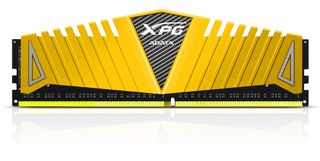Adata's XPG Z1 Gold Edition Is Some Speedy DDR4 Memory
Adata's new DDR4 memory offers promising speeds and a fancy new color.

When DDR4 launched earlier this year, together with Intel's Haswell-E CPUs and the X99 chipset, we were all a bit disappointed in the frequencies, as they were lower than we would've liked to see. This wasn't completely surprising, though, as the operating voltage for DDR4 had been lowered from DDR3, but we still hoped for higher performance. More recently, though, we've been seeing more high-performing DDR4 memory kits. Today's kit comes from Adata, and it's called the Gold Edition XPG Z1.
Adata already announced the XPG Z1 memory back at the launch of DDR4, but the Gold Edition memory is clocked notably higher than its earlier counterparts. These modules run at 1.35 V and will operate at speeds between 3000 MHz and 3333 MHz, depending on the kit you buy. All the units feature CL16 timings and will push up to 26.6 GB/s.
Naturally, they feature Intel's XMP 2.0 profiles, so getting the motherboard to run them at their native frequencies is a snap.
The PCBs are manufactured with a 10-layer design and 2 oz of pure copper. They also come with oversized aluminum heatsinks, so chances are you'll easily be able to overclock them beyond their design specification with ease, too.
Adata did not announce pricing or availability.
Follow Niels Broekhuijsen @NBroekhuijsen. Follow us @tomshardware, on Facebook and on Google+.
Stay On the Cutting Edge: Get the Tom's Hardware Newsletter
Get Tom's Hardware's best news and in-depth reviews, straight to your inbox.
Niels Broekhuijsen is a Contributing Writer for Tom's Hardware US. He reviews cases, water cooling and pc builds.
-
InvalidError Now that's some serious DDR4: 3333-16 has slightly better latency than 1600-8 and just over twice as much bandwidth. Those with fat wallets can now have their cake and eat it.Reply -
yumri @InvalidError though the only computers which need that kind of bandwidth ussualy do it in such a way thta they need less speed but more bandwidth not equal or greater speed to less bandwidth thus why workstation use dual or quad channel with 1333 instead of just single or dual channel with 1866 which is starting to make a slight diffenrce in games just not enough to justify cost of itReply -
Drejeck Reply@InvalidError though the only computers which need that kind of bandwidth ussualy do it in such a way thta they need less speed but more bandwidth not equal or greater speed to less bandwidth thus why workstation use dual or quad channel with 1333 instead of just single or dual channel with 1866 which is starting to make a slight diffenrce in games just not enough to justify cost of it
Depends more on the ram controller than you would think. ECC memory isn't about speed, is about perfect job done well rather than speed. And this is why they should stop racing over speeds and start building up more GB into them, as a start 16GB, DDR3 ecc left us there, why go back to 4GB? Since the DDR4 can't dual channel at least start from 8GB. Renders are GB hungry.
-
EasyLover Ahhh! Great, at-last a good timing DDR4 RAM on the scene. Thanks to myself for holding on not to buy DDR4 for now as I'm planning on X99. Will wait for some more time till more high frequency RAMs are rolled out. But what about their impact on games. I think, it hardly matters.Reply -
yumri @Drejack oh they have been the largest DDR3 DIMMs are 32GB atm with the "Best" of them beinghttp://www.newegg.com/Product/Product.aspx?Item=N82E16820226585&nm_mc=AFC-C8Junction&cm_mmc=AFC-C8Junction-_-na-_-na-_-na&cm_sp=&AID=10446076&PID=3938566&SID= a 32GB DDR3 stick though only at 1066MHz CL7 but if you are more into speed then http://www.newegg.com/Product/Product.aspx?Item=N82E16820147385&nm_mc=AFC-C8Junction&cm_mmc=AFC-C8Junction-_-na-_-na-_-na&cm_sp=&AID=10446076&PID=3938566&SID= at 1600MHz CL11 but in realailty they will run about the same speed becuase of the latency and speed changesReply
So DDR3 goes up to and includeing 32GB sticks and DDR4 is at 32GB 2133 CL15 http://www.newegg.com/Product/Product.aspx?Item=N82E16820148897&nm_mc=AFC-C8Junction&cm_mmc=AFC-C8Junction-_-na-_-na-_-na&cm_sp=&AID=10446076&PID=3938566&SID= and should be able to go faster with lower latency and higher density too as that was mainly just a technical signaling change to the electronic signal paths on the RAM not really how the chips are organized to make room for more chips and/or higher density chips. For higher density chips most likely we will have to wait on samsung to make a move for that or their 1 competeing company in Flash and NAND chip manufactuering.
Most Popular




